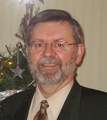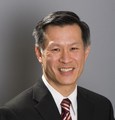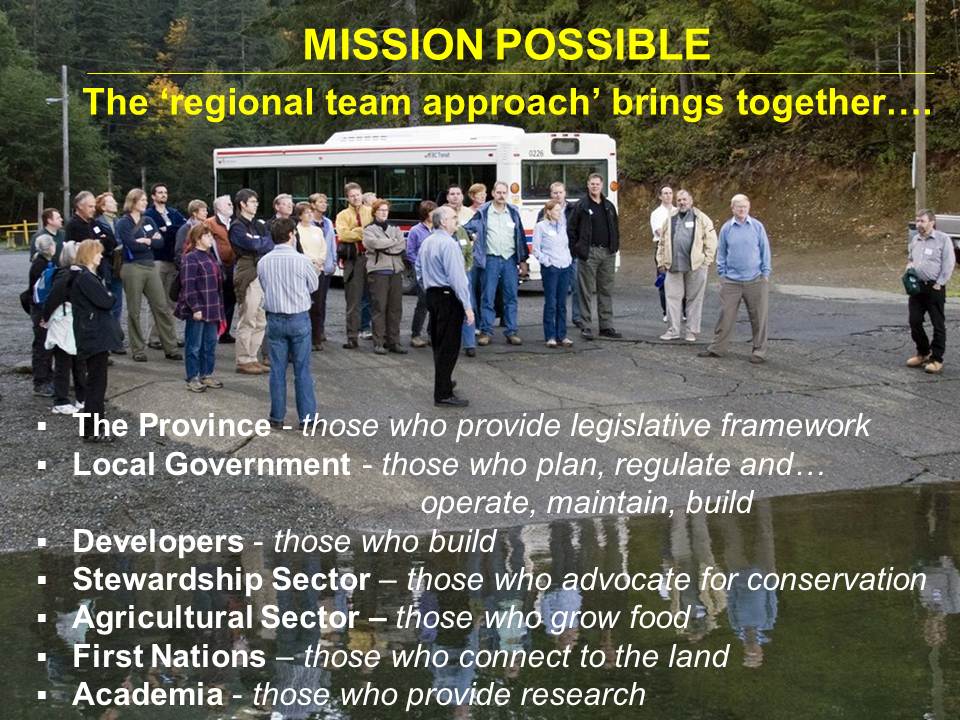Mission Possible: A 50-Year Vision for Urban Watershed Restoration
Note to Reader:
In February 2011, the Federation of Canadian Municipalities (FCM) held its Sustainable Communities Conference in Victoria, British Columbia. In the session titled ‘STEAL THIS IDEA!’, eight innovators from across Canada shared their breakthrough examples of municipal sustainability.
Each innovator hosted a roundtable. Kim Stephens, Executive Director for the Partnership for Water Sustainability in British Columbia, introduced delegates to the Water Sustainability Action Plan for British Columbia. His roundtable topic was Mission Possible: A 50-Year Vision for Urban Watershed Restoration.
The story presented below serves two purposes: captures the essence of the Mission Possible messaging; and connects the dots between the FCM Conference and a co-presentation by Glen Brown and Raymond Fung at the annual convention of the Union of BC Municipalities, held in September 2010.
Mission Possible
“In British Columbia, the Partnership for Water Sustainability has a vision for reconnecting communities with the land. Simply put, we believe if we respect the land, WATER SUSTAINABILITY will follow. Getting there requires a change in mind-set…. and LAND ETHIC,” stated Kim Stephens in his topic overview.
“We are CONNECTING THE DOTS between land use planning, development, watershed health AND infrastructure asset management. When communities are guided by a DESIGN WITH NATURE philosophy, water sustainability can be achieved. It will be achieved by implementing GREEN INFRASTRUCTURE policies and practices.”
 “We describe this as MISSION POSSIBLE….. because those operating in the local government setting can now access tools and experience…… that will enable them to make a difference. Our approach is TOP-DOWN / BOTTOM-UP. It is keyed to three words: ALIGNMENT, COLLABORATION, INTEGRATION.”
“We describe this as MISSION POSSIBLE….. because those operating in the local government setting can now access tools and experience…… that will enable them to make a difference. Our approach is TOP-DOWN / BOTTOM-UP. It is keyed to three words: ALIGNMENT, COLLABORATION, INTEGRATION.”
“We are CONVENING FOR ACTION. When we gather, it is for a purpose. There must be an outcome. We are challenging those in local government: WHAT DO YOU WANT THIS PLACE TO LOOK LIKE IN 50 YEARS? To get there, you will have to start now. Actions ripple through time.”
“Water sustainability is the lens to focus attention on how we can manage the BUILT ENVIRONMENT more sustainably. We will be successful when SETTLEMENT CHANGE IS IN BALANCE WITH ECOLOGY. This is how we will restore the health of our URBAN WATERSHEDS.”
Convening for Action in British Columbia: Alignment, Collaboration and Integration
“CONVENING FOR ACTION is a framework that brings stakeholders together, supported by the province, but led by local government. Collaboration and integration: it  is a true bottom-up approach that identifies the issue and then seeks to address it through the alignment of all stakeholders, with emphasis on local government needs. Vancouver Island is the demonstration region for ‘convening for action’, and is a success story”, states Glen Brown, Executive Director with the BC Ministry of Community, Sport and Cultural Development.
is a true bottom-up approach that identifies the issue and then seeks to address it through the alignment of all stakeholders, with emphasis on local government needs. Vancouver Island is the demonstration region for ‘convening for action’, and is a success story”, states Glen Brown, Executive Director with the BC Ministry of Community, Sport and Cultural Development.
Success on the Ground
“CAVI, the acronym for the Convening for Action on Vancouver Island initiative, demonstrates what can be accomplished when there is alignment at three scales: provincial, regional and local. CAVI is the model for Asset Management BC. Just like CAVI, it depends on the on-the-ground practitioners (engineers, planners, finance, elected officials, etc) to work through the issues with support and input from other stakeholders.”
“From a ‘tool’ perspective, the ‘convening for action’ approach has resulted in the Water Bucket Website, the web-based Water Balance Model (including a Tree Canopy Module that is under development), other web-based calculators such as the Water Conservation Calculator, Topsoil Primer and Shared Responsibility Matrix. In short, the ‘convening for action’ partners have built a suite of tools. This is steadily and effectively filling the toolbox.”
“We recognize that the Partnership for Water Sustainability need not to be the owner or the developer of a tool. Rather, through CONVENING FOR ACTION, we support other tools and implementation – in fact, we have been ‘stealing ideas’ when appropriate as a part of our business.”
Implementing the New Culture
Released in June 2010, Beyond the Guidebook 2010: Implementing a New Culture for Urban Watershed Protection and Restoration in British Columbia tells the stories of the ‘convening for action’ champions in the BC local government setting.
 The formal rollout of Beyond the Guidebook commenced in September 2010 at the annual convention of the Union of BC Municipalities. Glen Brown and Ray Fung (District of West Vancouver) represented the provincial and local government perspectives, respectively, in delivering an integrated presentation on behalf of the “convening for action” partnership.
The formal rollout of Beyond the Guidebook commenced in September 2010 at the annual convention of the Union of BC Municipalities. Glen Brown and Ray Fung (District of West Vancouver) represented the provincial and local government perspectives, respectively, in delivering an integrated presentation on behalf of the “convening for action” partnership.
“The philosophy behind the Water Sustainability Action Plan is quite simple: bring local and regional stakeholders together where there is a desire and energy to make some form of change,” explained Glen Brown when he elaborated on the ‘regional team approach’.
“As we move forward with the Action Plan, it is making sure that we provide the people on the ground with the tools and resources that they need to help support action at the local level.”
“A top-down approach does not work. It is all about being bottom-up… that is to say, the regional team approach. When a community shows interest or a desire to move something forward, that is when we mobilize. The Action Plan purpose is to engage, listen, understand and support the local interests in moving forward. That is where we have been successful.”
Shared Responsibility
“There are a lot of times when we in local government like to blame or put on senior governments the responsibility to provide the framework for doing something…but there are things that we in local government can do. We need to choose to be enabled,”  Ray Fung told the UBCM audience.
Ray Fung told the UBCM audience.
“So, what we mean by shared responsibility is that everyone has a role, and everyone can act…. all levels of government, developers, regulators, bureaucrats, consultants, planners, engineers…. we all have a role.”
Links to YouTube Videos:
To view a 3-minute video clip of Glen Brown elaborating on the ‘regional team appoach’ at the 2010 UBCM Annual Convention, click here.
To view a 90-second video clip of Ray Fung speaking about Shared Responsibility, click here.
About ‘Steal This Idea’
 For more information on the STEAL THIS IDEA! session, click on FCM Sustainable Communities Conference showcases BC’s Water Sustainability Action Plan
For more information on the STEAL THIS IDEA! session, click on FCM Sustainable Communities Conference showcases BC’s Water Sustainability Action Plan
“Three half-hour sessions gave participants the chance to check out their favourite ideas and get the scoop on how to bring them back to their own communities,” explains Azzah Jeena, the person responsible for organizing the session on behalf of FCM. “This session was held for the first time during the 2010 conference and it was very popular with delegates.”
 The session was moderated by Emanuel Machado. He is Manager of Sustainability Services and Special Projects with the District of Sechelt, BC. Previously, he was with the City of Dawson Creek. He provides this personal perspective on the Water Sustainability Action Plan and what it has meant to him as a practitioner in local government:
The session was moderated by Emanuel Machado. He is Manager of Sustainability Services and Special Projects with the District of Sechelt, BC. Previously, he was with the City of Dawson Creek. He provides this personal perspective on the Water Sustainability Action Plan and what it has meant to him as a practitioner in local government:
Inspiring Action in Dawson Creek
“Water in BC is under-valued, under-priced and over-used. The Water Bucket website is having a tremendous impact in helping communities in BC address that challenge by providing awareness, tools and resources that build capacity.”
“Local governments are transitioning from simply pumping and treating water to managing earth’s most precious resource. An example of that transition can be seen in Dawson Creek (in Northeast British Columbia), a city at the forefront of the pressure being felt by communities across Canada due to climate change impacts and increased residential and industrial demands on aging water systems.The December 2006 workshop that introduced the City to BC’s Water Sustainability Action Plan was a catalyst for that change.”





